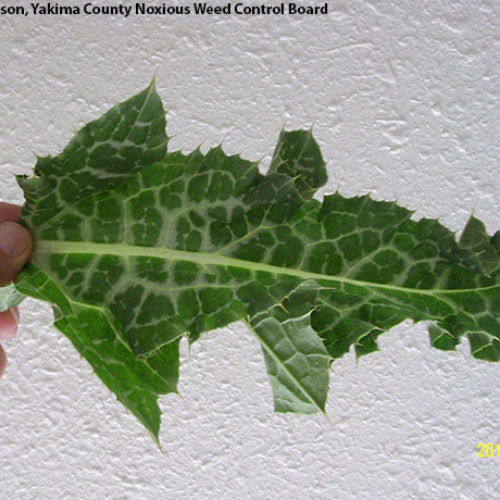Milk Thistle
Silybum marianum

Family: Asteraceae
Other Common Names: blessed milkthistle, spotted thistle, variegated thistle
Weed class: A
Year Listed: 1989
Native to: Western Asia, Europe and Northern Africa
Is this Weed Toxic?:
livestock
Legal listings:
This plant is also on the Washington State quarantine list. It is prohibited to transport, buy, sell, offer for sale, or distribute plants or plant parts of quarantined species into or within the state of Washington or to sell, offer for sale, or distribute seed packets of seed, flower seed blends, or wildflower mixes of quarantined species into or within the state of Washington. Please see WAC 16-752 for more information on the quarantine list. For questions about the quarantine list, contact the Washington State Department of Agriculture's Plant Services Program at (360) 902-1874 or email PlantServices@agr.wa.gov.
Why Is It a Noxious Weed?
It is an aggressive invader that threatens native vegetation and beneficial forage. It is a prolific seeder and forms dense stands. It is a nitrate accumulator. Ingestion of milk thistle by grazing animals causes nitrate poisoning which can be lethal.
How would I identify it?
General Description
Milk thistle is a sparsely branched thistle growing up to 6 feet tall with distinctively patterned green and white leaves.
Flower Description
Flowerheads are large and rounded, occurring at stem tips. Flowers are purple and all tubular (all disk flowers). Flowerheads with leathery, spine-tipped bracts at the bases. Bracts in many overlapping rows with spreading tips.
Leaf description
The leaves are alternate, deeply lobed, have pointed tips. They are shiny dark green with conspicuous white marbling. Basal leaves can be 20 inches long and 10 inches wide.
Stem description
The stems are stout, rigid, branching and slightly cobweb-like. They end in a solitary composite flowerhead.
Fruit Seed Description
Seeds are hairless and about ¼ inch long.
Where does it grow?
Milk thistle occurs on fertile lands of improved pastures that have been overgrazed and poorly managed. It’s found in dense stands along roadsides, waste areas, pastures are invaded from roadside populations, ditches and disturbed areas. Please click here to see a county level distribution map of milk thistle in Washington.
How Does it Reproduce?
Milk thistle reproduces by seed.
How Do I Control It?
General Control Strategy
Thistles are most susceptible to control during the seedling stage, or as they grow from the seedling stage to the rosette state. An integrated pasture management approach is effective for thistle control.
Mechanical Control
Hand-pull (wearing good gloves!) or dig up young plants, and be sure to clip flowerheads of mature plants and dispose of them in the trash before the seeds ripen. Mowing is not recommended, as it may produce more plants the next year.
Herbicide Control
Please refer to the PNW Weed Management Handbook, or contact your county noxious weed coordinator.
For More Information
See our postcard for early detection information about milk thistle.
See our Written Findings for more information about milkthistle (Silybum marianum)
Thurston County NWCB Fact Sheet on milk thistle
Cowlitz County NWCB Fact Sheet on milk thistle
Jefferson County NWCB Fact Sheet on milk thistle
Pierce County NWCB Fact Sheet on milk thistle
Clark County NWCB Fact Sheet on milk thistle
King County NWCB Fact Sheet on milk thistle
Control Options for milk thistle from King County NWCB
Report from Weed Control in Natural Areas in the Western United States














